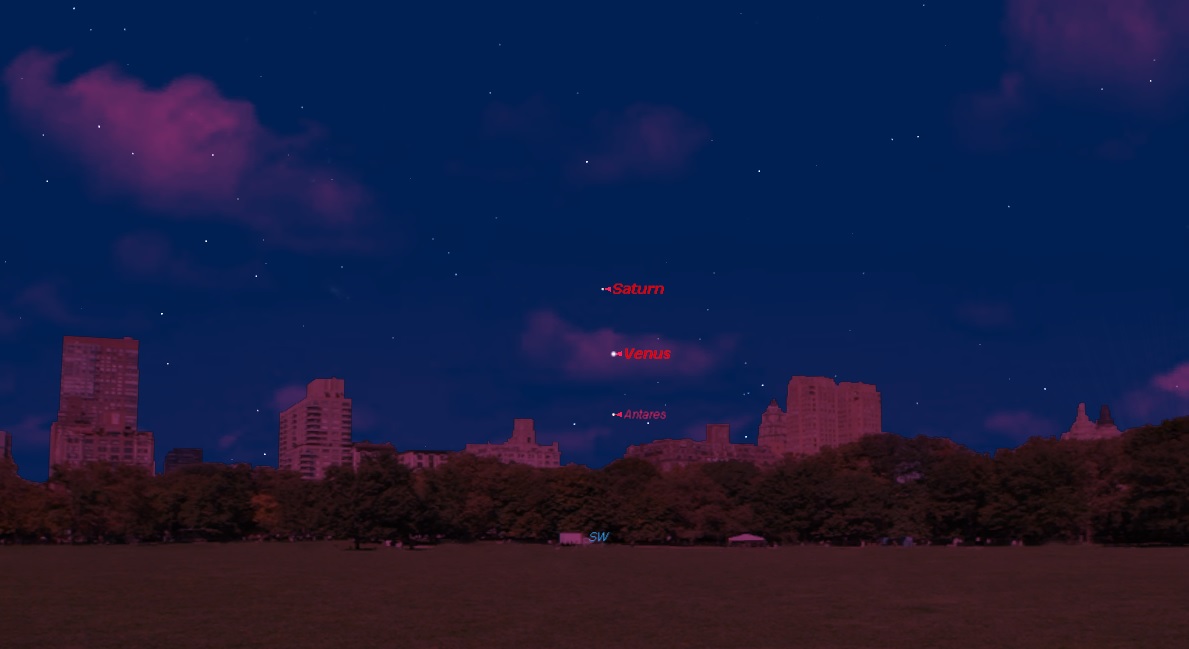
About a half-hour after sunset Thursday evening (Oct. 27), look low in the southwest sky to spot a planetary/stellar lineup of two bright planets and one of the brightest and most colorful stars in the sky.
The two planets — the brilliant Venus and yellow-white Saturn — will appear to form a nearly perfect vertical line in the sky with the 15th brightest star, the reddish supergiant Antares.
Venus will be in the middle of the lineup. Saturn will sit about 3 and one-half degrees above it, while Antares will lie about 3 and one-half degrees below Venus. The range of brightness among the three objects spans five magnitudes. Venus glows at a vibrant magnitude -4.0, while Antares appears only a hundredth as bright, at magnitude +1.0. Saturn shines at magnitude +0.5, nearly twice as bright as Antares, though only 1/63 as bright as Venus. [The Best Night-Sky Events of 2016: What to Watch for This Year]
Since your clenched fist measures roughly 10 degrees in width when held at arm's length, the length of the Saturn/Venus/Antares lineup will stretch about "three-quarters of a fist" in length.
Binoculars will help
If you search for this lineup, it will help considerably if you use binoculars. Venus will be distinct to the naked eye, but it will likely be more difficult to pick up Saturn and especially Antares against the rather bright twilight sky unaided. Antares also has the unfortunate distinction of being the lowest of the three, less than 10 degrees ("one fist") above the southwest horizon, just 30 minutes after sundown.
And while all three objects resemble stars, only Antares will seem to twinkle. Although it measures hundreds of times larger than Earth's sun, at a distance of 550 light-years (3.3 quadrillion miles), it looks to Earthlings like a glowing dot, even in large telescopes. So its light is easily distorted by Earth's boiling atmosphere, hence the twinkling effect.
In contrast, Venus and Saturn — located only 114 million miles (183 million kilometers) and 1 billion miles (1.6 billion km) from Earth, respectively — appear as distinct disks through telescopes. They very rarely appear to twinkle.
Get the Space.com Newsletter
Breaking space news, the latest updates on rocket launches, skywatching events and more!
Farewell, Antares and Saturn
After Thursday, Venus will rapidly leave Saturn and Antares behind as it moves away to the east. The planet will gradually increase in prominence in the weeks and months to come, ultimately becoming a stupendously dazzling evening star by midwinter early next year.
In contrast, Antares and Saturn will soon bid evening skywatchers a fond adieu, dropping into the sunset fires. Antares will disappear first, about a week after the lineup occurs, and Saturn will leave by month's end. They will both come back into view in December, low in the southeast before sunrise.
Joe Rao serves as an instructor and guest lecturer at New York's Hayden Planetarium. He writes about astronomy for Natural History magazine, the Farmer's Almanac and other publications, and he is also an on-camera meteorologist for News 12 Westchester, N.Y. Follow us @Spacedotcom, Facebook and Google+. Original article on Space.com.
Join our Space Forums to keep talking space on the latest missions, night sky and more! And if you have a news tip, correction or comment, let us know at: community@space.com.

Joe Rao is Space.com's skywatching columnist, as well as a veteran meteorologist and eclipse chaser who also serves as an instructor and guest lecturer at New York's Hayden Planetarium. He writes about astronomy for Natural History magazine, Sky & Telescope and other publications. Joe is an 8-time Emmy-nominated meteorologist who served the Putnam Valley region of New York for over 21 years. You can find him on Twitter and YouTube tracking lunar and solar eclipses, meteor showers and more. To find out Joe's latest project, visit him on Twitter.









